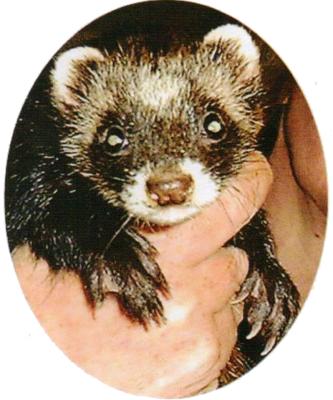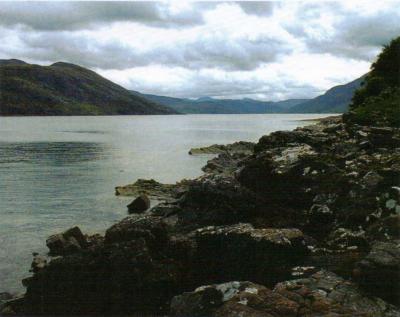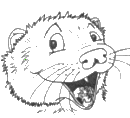Back to Basics - Along Came Polly
June McNicholas tells the inspirational story of how Polly the wild polecat was caught between two worlds after an act of terrible cruelty left her unable to fend for herself. Could this amazing beautiful but fearful creature learn to adapt to captivity by 'acting' domestic ferret?
There have been lots of unconfirmed reports of polecats being taken from the wild to interbreed with ferrets, of hybrid kits for sale and of 'acidental' matings between wild polecats and ferrets,
They are difficult to verify and difficult to justify. It's taken centuries of selective breeding to produce the sociable, gregarious, outgoing domestic ferret from the shy, solitary, and largely unmanageable polecat. So why try to reintroduce the very qualities that it has taken so long to remove?
Most reports of know hybrids are that they are either too shy, too nervous or too aggressive to be useful as pets or working animals. However, their extra dark colours make them amazingly beautiful. Could this be the reason for interbreeding? That someone is so lured by winning 50p worth of coloured ribbon at a show that they discard ferret welfare and any regard for the law on protected wild species?
Maybe. We never really had any evidence until... Along came Polly.
Polly is a wild polecat unable to be released to the wild because someone has clipped all her teeth to gum level. Perhaps she was taken from the wild, perhaps she was to difficult to handle. Such unspeakable cruelty means she could now never make a successful predator. In most situations she would have been put down as an unsuccessful candidate for rehabilitation but Polly was given another chance - if she could just learn to 'act ferret'. The question was: 'Would her natural behavious allow her to adapt to communal life with a ferret group?'
 Polly was taken in by the late Adrie Walker who, realising that this was no normal rescue ferret, had taken her to a wildlife hospital for rehabilition. Since rehab was not an option, Polly found her way to Julie Stoodley at Sleaford Ferret Rescue. Julie worked her usual magic and Polly regained health and, to some degree.confidence although she spent most of her time in a tube, shunning all human attention.
Polly was taken in by the late Adrie Walker who, realising that this was no normal rescue ferret, had taken her to a wildlife hospital for rehabilition. Since rehab was not an option, Polly found her way to Julie Stoodley at Sleaford Ferret Rescue. Julie worked her usual magic and Polly regained health and, to some degree.confidence although she spent most of her time in a tube, shunning all human attention.
Polly was caught between two worlds. She was a wild animal who couldn't be released yet she was not going to be easily domesticated and live contentedly in captivity. Julie asked us if we had any ideas.
The first thing we had to establish was whether Polly was a true polecat. We contacted Johnny Birks who worked for many years on the National Polecat Survey for the Vincent Polecat Trust. Johnny told us he knew of no available DNA tests to distinguish between polecats and ferrets but that there are various other clues we could look for. Polly fulfilled all the criteria for a wild polecat that could be detected in a live animal.
Polly came to us. We had three options for her. Firstly, we could try to see if she could ever adapt to life as a ferret. Secondly, we could attempt to give her a solitary but peaceful enclosure in which to live out her days. If neither of these out, we would take her with us when we moved to Scotland and re-home her with the Highland Wildlife Park, sponsoring a large secluded enclosure, and her keep for the rest of her life.
Polly was amazingly beautiful, but fearful, suspicious and very reluctant to leave the safety of her tube. She lived like a hermit crab in its shell, just poking her head out occasionally. The one thing that seemed to interest her was a motley group of assorted rescue kits in the next enclosure. One in particular seemed to break down some of Polly's reserve. Rush is a hyperactive lunatic polecat hob who lives up to his name. His madcap antics seemed to fascinate Polly, although she wouldn't leave her tube to investigate. Rush knew she was there, though, and danced even harder, chuckling away cheerfully.
It took some days but eventually Polly emerged from her tube and ventured up to the wire. Rush was ecstatic and bounced, pounced and danced even more. We have no way of knowing what Polly thought of him, she might have been thinking he was bonkers for all we know, but she became more at ease about standing at the wires of her run to watch him.
It wasn't an easy decision to introduce them properly. Despite Polly having most of her teeth clipped she could still have hurt him badly. Even if she didn't, the whole episode could set her back permanently if it was unsuccessful. However, since she did not seem to have much of a life in her tube and she did, at least, seem interested, we thought it worth a try.
If it didn't work, she would go to the Wildlife Park where she need not have anything much to do with people or other animals.
Rush thought it wonderful to meet Polly. But then, everything is wonderful to Rush. He has the happiest, most carefree, nature you could ever meet. He was happy whatever she did. If she wanted to swear at him, great, that was worth a celebration dance. If she wanted to hide in a tube, that was great, too. He'd just dance in front where she could see him. Over the next few days, the other kits in Rush's group joined him and Polly. They really didn't take much notice of Polly at all. It was as if they thought a rather strange character had joined them. Harmless, a bit boring, probably a bit potty, and with a definite tube obsession, but on the whole, OK.
Polly continued to live in her tube most of the time, especially if we were about. It meant that when the kits were moved from one run to another, or to their night quarters, Polly had to 'travel by tube' since the only way of transporting her was to lift the whole tube from one pen to another. Then, some weeks later, her tube was empty. Polly was in a nest box with Rush, She would still dash back to her tube when we started to lift the kits from the pen, but she started to spend more time with Rush and less time in her tube.
It's easy to make the mistake of becoming complacent when things start to go right - and I did. Polly and I had worked out the night time move routine. I'd move all the other kits and go back for Polly. She would co-operate by going into her tube and sitting quietly while I carried her in the tube to the night quarters. I was quite proud of this seemingly settled, orderly, way of doing things. Well, they say pride goeth before a fall, and it was true. Something spooked her while I was carrying the tube. I was being less watchful and careful about keeping both ends of the tube covered with my hands. The result was that Polly gave an ear splitting scream and shot out of the tube on to the ground and away across the yard, past the stable and under the gate towards the hills. To give you an idea of how remote we are up here and how much wilderness there is, the most densely populated area has about 40 houses in 60 miles, with hundreds of miles where there are no houses, roads, or anything but mountains, moors and lochs. Wonderful - until you lose a polecat.
I honestly had little hope of her ever being seen again, and I knew she had even less chance of surviving. Unable to hunt properly, and with a very active population of predators such as eagles, foxes, pine martens, and wild cats, I felt my carelessness had sentenced Polly to death. I searched and searched, but even if I had found her I had to admit to myself that we wouldn't have been able to catch her. As a last resort, I put Rush on a harness and we went
 walkabout around the perimeters of the croft. Rush didn't seem to be a lot of use. He took me through hedgerows, down drainage ditches and even tried to lead me under the lambing pens. We explored the barn, the stable, the flowerbeds and just about everywhere until we came to the upturned rowing boat belonging to our shepherd which he leaves at the side of our croft gate. Rush pulled hard to get underneath the boat. And there was Polly, shivering and shaking. She greeted Rush with touching enthusiasm, but she wouldn't let me reach into her. Instead I had to go and get her tube and, with Rush's guidance, she allowed herself to be steered into it and back home to safety.
walkabout around the perimeters of the croft. Rush didn't seem to be a lot of use. He took me through hedgerows, down drainage ditches and even tried to lead me under the lambing pens. We explored the barn, the stable, the flowerbeds and just about everywhere until we came to the upturned rowing boat belonging to our shepherd which he leaves at the side of our croft gate. Rush pulled hard to get underneath the boat. And there was Polly, shivering and shaking. She greeted Rush with touching enthusiasm, but she wouldn't let me reach into her. Instead I had to go and get her tube and, with Rush's guidance, she allowed herself to be steered into it and back home to safety.
Polly hardly left Rush's side for days after that. She needed the security of his proximity. However, it was as if the episode had made the bond even stronger, for whatever Rush would do, she would follow suit. When he came to greet us, Polly would come too, although hanging back a little suspiciously. But it was though this sort of trust she had for Rush that she eventually learned to be more like a ferret than a polecat. One day, nearly six months after she had been with us, she danced for the first tiem, She stopped when she saw us watching. Clearly the dance was for her ferret friends, not for us. We started putting the group in a stone building formerly used as a small cattle byre and we were able to watch through the small side window. Polly could dance, jump and chuckle as well as the rest of her map-cap group, Julie was almost moved to tears when she visited and witnessed for herself how Polly was shaping her new life.
Polly will never be tame in comparison to ferrets, but she can be handled when needed and she adores her ferret family. We have a very minor role in her life but we believe she is happy. Much of her social behaviour has been modified by her ferret companions but she retains a definite wild streak. She hates strangers and becomes upset by high winds and bad weather, or loud noises. She is largely mistrustful of people and we have to pick our times to handle her for health checks and ear and feet inspections.
Poor Polly. Although we feel privileged to have her and watch her, her life should have been so different and there are times we feel great sadness at what some uncaring, unthinking, person has inflicted on her.
Maybe she will live longer, never know hunger or the fear of predators, but hers is not the life she was born to. I only hope we can continue to make her as happy as we can.
(From Ferrets First Issue no. 19 - August/September 2004)
